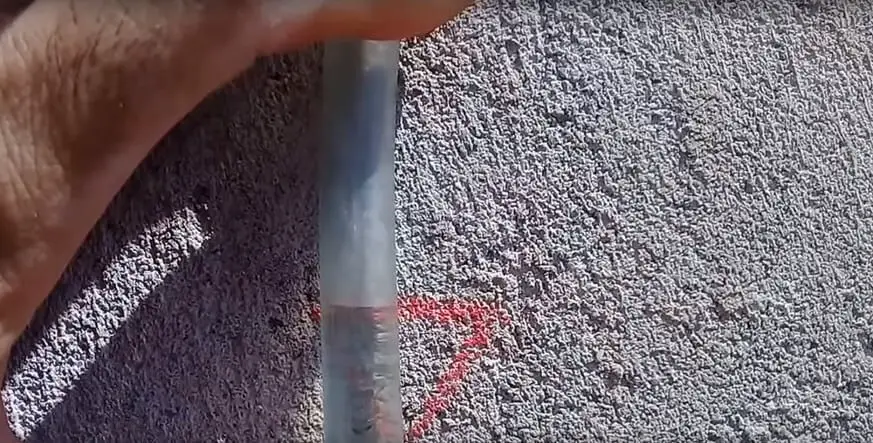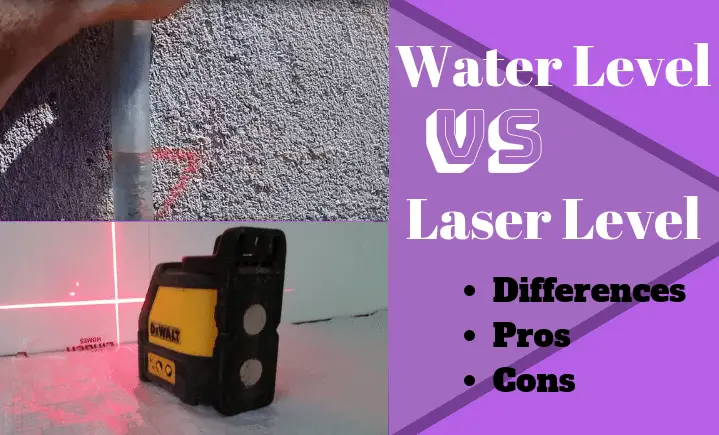Is the water level a reliable tool, or should I choose to have a laser level instead?
Yes, NinjaDIYers … there are a few questions similar to the one above that people are asking when it comes to which of these two leveling devices is better to use or more accurate…
… The Laser Levels Or Water Levels?
I’ll answer these questions for you today! But first …
What Are These Levels Used For Anyway?
It’s no secret that levels are an essential tool when it comes to building around the house or on the construction site. Whether you’re framing walls or doing interior finishing or laying out the foundations for a home, using a level is the best way to make sure that things are as straight and level as possible. Since we’re talking about it, here’s what some pros believe to be the best laser level for foundations and framing a basement.
In most cases, people will use a laser level for their building needs.
However, for centuries, builders have been using basic water levels, which can be almost as accurate and versatile as a modern laser level.
In fact, water levels can be used in some situations when a laser level can’t, such as leveling “through” or around obstacles.
Furthermore, water levels are a much more affordable alternative to a laser level, can be built by only a few simple items from your local hardware store and are super easy to use once you understand the concept.
On the other hand, laser levels are a newer invention and, in some ways, are a little bit simpler to use than a water level.
As their name suggests, they use a laser beam that can be projected across any surface and will always make perfectly straight lines as long as the level itself is set up properly.
Regardless of their differences, both water levels and laser levels have their own advantages and disadvantages. Below, we’ll take a look at both types of levels, as well as when and how to use them.
Water Levels

Water levels have been used for hundreds of years and are an ancient take on our modern types of leveling tools. Typically, water levels are made by using some sort of clear plastic tubing and filling it with water, or some other sort of thin, watery liquid.
This type of level relies on a very basic principle: gravity, and naturally, the surface of the water will always seek a level plane.
Therefore, water levels can easily be used as an alternative to a modern laser level.
BTW, I didn’t know about this until recently … but they’ve even created an electronic water level 🙂
Also, water levels can be accurate across large distances. This is because they are not degree dependent and no matter where they are used, the water inside the tubing will always find its own level point.
This means that water levels are great for applications where there are obstructions in the way that would block a modern laser level from being effective. You simply need to use a piece of tubing that is long enough to reach around the obstacle, and then you’ll easily be able to transfer marks on the surface you’re working with.
How To Make And How To Use A Water Level
Using a Water Level
To make and use a water level, you simply need to fill a length of flexible tubing with water, leaving about a foot of empty space on either end of the tube.
Next, clamp or secure one end of your plastic tubing to your reference point. Just make sure that you’re not pinching the tube.
Then, you’ll be able to transfer your initial reference point to the other surface by measuring the distance from the end of the tube to the water line and making sure that you have the same measurement on the other end of the hose.
Pros
- Allows you to level “through” or around obstructions
- Easy to build
- Inexpensive alternative to laser levels
Cons
- Not quite as accurate as a laser level
- Time-consuming to set up
- Can only be used for horizontal leveling
Laser Levels

Laser levels are much more modern inventions and emit a laser beam that can be used to project level lines across a surface. There are different types of laser levels. Some will project horizontal and vertical lines, while others are used to project one or more points on a surface.
Furthermore, there are also laser levels that can be used for both lines and individual points like the Bosch Ghttp://ninjadiy.com/gpl-3-laser-level-review/PL3 for example that project 3 simple dots.
Before being used, laser levels need to be leveled out first. In most cases, laser levels have a built-in leveling function, but there are some laser levels out there that may require being leveled out manually.
This means that laser levels are degree dependent and need to be set up on a flat surface in order to be as accurate as possible.
There are many different applications for laser levels. They can be used for all sorts of different construction applications such as laying out foundations and framing walls, however, they can also be used for smaller interior jobs such as
- finishing precision carpentry work
- or even just leveling the crooked picture frames on your living room walls.
Using A Laser Level
To use a laser level, you’ll first need to find a solid surface and set up your laser level. Once set up, turn the laser level on and let it zero itself out, or do it manually if required.
Then, you’ll be able to project a perfectly straight and level line across whatever type of surface you’re working with. With this, you can use to line as a reference point to take measurements and transfer marks wherever needed.
Below there’s a very cool video showing you how to the different type of laser level are working:
- Dot/Point laser levels
- Line laser levels
- Cross-line laser levels
- 360 rotary laser levels
Hit play in order to learn more …
How To Use The Different Types Of Laser Levels
Pros
- Highly accurate across short distances
- Can be used to project both vertical and horizontal lines
Cons
- Can’t be used to project lines across large distances
- Expensive compared to a water level
- Fragile
Conclusion: Water Level Or Laser Level?
In the end, both water levels and laser levels have their own types of uses. Although water levels are an ancient method of leveling things, they are still highly effective, versatile.
Great for smaller projects around the house. Especially when it comes to “blind” leveling around corners or obstacles.
On the other hand, laser levels are best for professional builders who need a higher degree of precision and versatility. They can be used for many different construction needs and will always be accurate within short distances as long as they are set up properly. Having said that … nowadays, many DIYers (most of them) have a laser tool in the cupboard as well.
I prefer laser levels!
You can find laser levels on Amazon for as high as one or two thousand dollars and for as low as 50-100 bucks and. Then again, you will make your decision to buy a laser level depending on your budget and the reasons you want to own a laser level.
By now, you should have a better understanding of both water levels and laser levels. And, with this information, you’ll be able to tackle your next big project and ensure that your finished product will turn out as straight and accurate as possible.
Anyway, ninjas, I hope this little “Water VS Laser Level” article helped you to have a better understanding of what are the differences between these two leveling devices. Let me know in the comments below if it helped or maybe which one do you prefer?
In the meantime…
Stay Safe Ninjas And Happy DIYing! 🙂
[wpsm_titlebox title=”Please Rate My Article” style=”3″]Did you like the article? Was it helpful? I’d appreciate it if you’d give me a 5-star when you have 2 seconds. It helps me keep putting these awesome articles out for you! Cheers! [kkstarratings][/wpsm_titlebox]



We use water levels daily to hang commercial doors, they are very accurate at times I think even better than laser. One man operation is easy when placed on a ladder and unlike laser levels whose red line can dissapear in a bright opening, we can see the water line in the same situation. Old school is definitely the way to go in my opinion.
Hey Mike,
I agree with you. Sometimes is much more convenient to use the water level. And it could become an easy practice once you’ve found a way to do it by yourself just like you mention by using a ladder 🙂
One of the reasons I like much more the laser levels is because they are so easy to set up…
But it’s always great to know how to use the old school tools (will give you an edge over the other guys)
Thanks for leaving a comment!
Thanks for this post. I wasn’t sure what the difference was. I’m not a professional so now you’ve made it a little bit more clear for me.
It looks like I’ll go with a laser level instead of a water level haha.
Fewer things to mess around with lol.
Hey Chris,
Thanks for stopping by and for letting me know that it helped.
Personally, I only use laser levels on my day job and for my DIY as well.
It’s so much easier. You can do so many tasks just by setting the laser level into position and that’s it. Whereas using a water level, you’ll need someone to help you out.
My favorite: Laser Levels. That’s my opinion anyway!